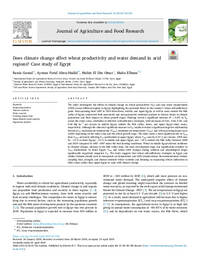Does climate change affect wheat productivity and water demand in arid regions? Case study of Egypt

Authors:
The study investigates the effects of climate change on wheat productivity (Yw) and crop water requirements (CWR) across different regions in Egypt, highlighting the potential threat to the country's wheat self-sufficiency goals. Data spanning from 1987 to 2019 from lower, middle, and upper Egypt, as well as areas outside the Nile valley of Egypt, underwent both parametric and non-parametric statistical analysis to discern trends in climate parameters and their impact on wheat growth stages. Findings reveal a significant increase (P ≤ 0.05) in Yw across the study areas, attributed to effective self-sufficiency strategies, with increases of 0.61, 0.60, 0.59, and 0.56 Mg ha−1 per decade in middle Egypt, outside the Nile valley, lower, and upper Egypt study zones, respectively. Although the observed significant increase in Yw, results revealed a significant negative relationship between Yw, maximum air temperature (Tmax), minimum air temperature (Tmin), and wheat growing degree days (GDD) depending on the study zone and the wheat growth stage. The study notes a more significant rise in Tmin than Tmax, adversely affecting Yw, particularly in upper Egypt, where Tmin rose by 0.43 °C per decade. CWR rose by ∼12 % in lower Egypt, ∼15 % in middle and upper Egypt, and ∼18 % outside the Nile valley between 2009 and 2019 compared to 1987–1997 under the best farming conditions. Wheat in middle Egypt showed resilience to climatic change, whereas in the Nile valley zone, the node development stage was significantly sensitive to Tmax fluctuations. In lower Egypt, Tmin and wheat GDD changes during anthesis and physiological stages significantly negatively impacted Yw. The study suggests that wheat self-sufficiency strategies in Egypt and similar climates should start to incorporate air temperature and GDD considerations. Recommendations include adopting heat, drought, and disease-resistant wheat varieties and focusing on expanding wheat cultivation in other zones rather than upper Egypt to cope with climate change.
